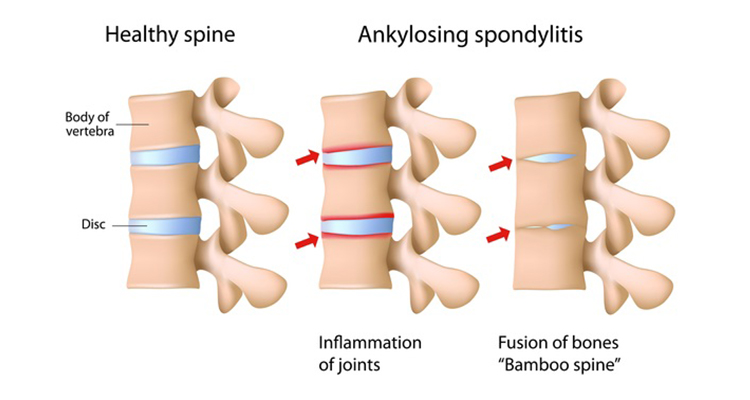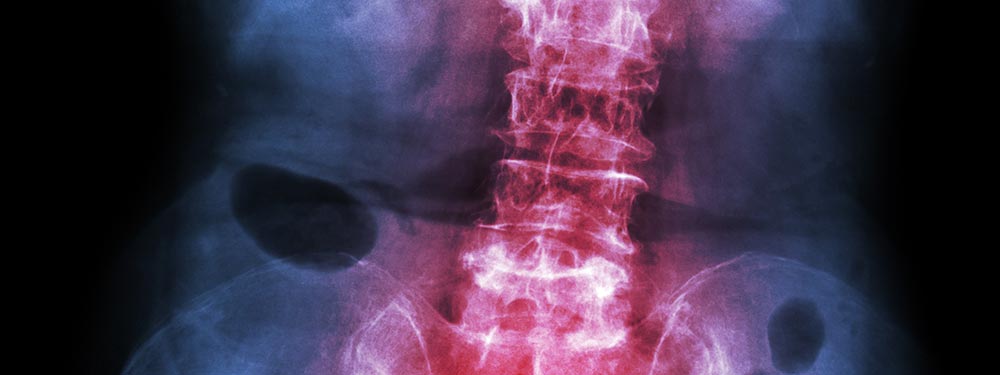Ankylosing Spondylitis is an inflammatory disease that can cause some of the vertebrae in your spine to fuse together.
This fusing makes the spine less flexible and can result in a hunched-forward posture. If ribs are affected, it may be difficult to breathe deeply.
Ankylosing Spondylitis affects men more often than women. Signs and symptoms of Ankylosing Spondylitis typically begin in early adulthood. Inflammation also can occur in other parts of your body — most commonly, your eyes.
While there is no cure for Ankylosing Spondylitis, our physicians at Advanced Rheumatology & Arthritis Wellness Center can provide the professional treatments you need to decrease your pain and lessen your symptoms.

Symptoms of Ankylosing Spondylitis
Early signs and symptoms of Ankylosing Spondylitis may include pain and stiffness in your lower back and hips, especially in the morning and after periods of inactivity. Over time, symptoms may worsen, improve or stop completely at irregular intervals.
The areas most commonly affected are:
- The joint between the base of your spine and your pelvis
- The vertebrae in your lower back
- The places where your tendons and ligaments attach to bones, mainly in your spine, but sometimes along the back of your heel
- The cartilage between your breastbone and ribs
- Your hip and shoulder joints
Diagnosis of Ankylosing Spondylitis
One of our physicians will perform a physical examination, which will entail looking for sites of inflammation. We will likely check for pain and tenderness along the back, pelvic bones, sacroiliac joints, chest and heels. During the exam, we may also check for the limitation of spinal mobility in all directions and for any restriction of chest expansion.
The overall points taken into account when making an Ankylosing Spondylitis diagnosis are:
- Onset is usually under 45 years of age
- Pain persists for more than 3 months (i.e. it is chronic)
- The back pain and stiffness worsen with immobility, especially at night and early morning
- The back pain and stiffness tend to ease with physical activity and exercise
- Positive response to NSAIDs (nonsteroidal anti-inflammatory drugs)
Treatment of Ankylosing Spondylitis
The goal of treatment is to relieve your pain and stiffness, and prevent or delay complications and spinal deformity. Ankylosing Spondylitis treatment is most successful before the disease causes irreversible damage to your joints.
- Medications: Nonsteroidal anti-inflammatory drugs (NSAIDs) — such as naproxen (Naprosyn) and indomethacin (Indocin) — are the medications doctors most commonly use to treat Ankylosing Spondylitis. They can relieve your inflammation, pain and stiffness. However, these medications also can cause gastrointestinal bleeding. If NSAIDs aren’t helpful, your doctor may suggest tumor necrosis factor (TNF) blockers. TNF is a cell protein that acts as an inflammatory agent in rheumatoid arthritis. TNF blockers target this protein to help reduce pain, stiffness, and tender or swollen joints. They are administered by injecting the medication under the skin or through an intravenous line.
- Physical Therapy: Physical therapy can provide a number of benefits, from pain relief to improved physical strength and flexibility. Your doctor may recommend that you meet with a physical therapist to provide you with specific exercises designed for your needs. Range-of-motion and stretching exercises can help maintain flexibility in your joints and preserve good posture. Proper sleep and walking positions and abdominal and back exercises can help maintain your upright posture.
- Surgery: Most people with Ankylosing Spondylitis don’t need surgery. However, your doctor may recommend surgery if you have severe pain or joint damage, or if your hip joint is so damaged that it needs to be replaced.
Prevention of Ankylosing Spondylitis
Because the specific cause is unknown, there are no means for the prevention of Ankylosing Spondylitis. The best hope is to take steps to help prevent the disorder from becoming worse by carefully following the prescribed treatment plan and staying active. Regular exercise helps relieve pain and increases flexibility. Maintaining a proper posture also helps reduce strain on the spine. Cigarette smoking, physically strenuous jobs or other health problems increase the loss of function from the disorder, so keeping a healthy lifestyle may help in preventing Ankylosing Spondylitis from becoming more serious.
Need Help Affording Medications?
Patients who are having difficulty paying for their medications, and who have federally funded Medicare, Medicaid, TRICARE, or commercial insurance, may qualify for additional support from the following foundations below:
- Chronic Disease Fund | www.cdfund.org | 877-968-7233
- Patient Access Network Foundation | www.panfoundation.org | 866-316-7263
- The Healthwell Foundation | www.healthwellfoundation.org | 800-675-8416
- Patient Advocate Foundation | www.copays.org | 866-512-3861



